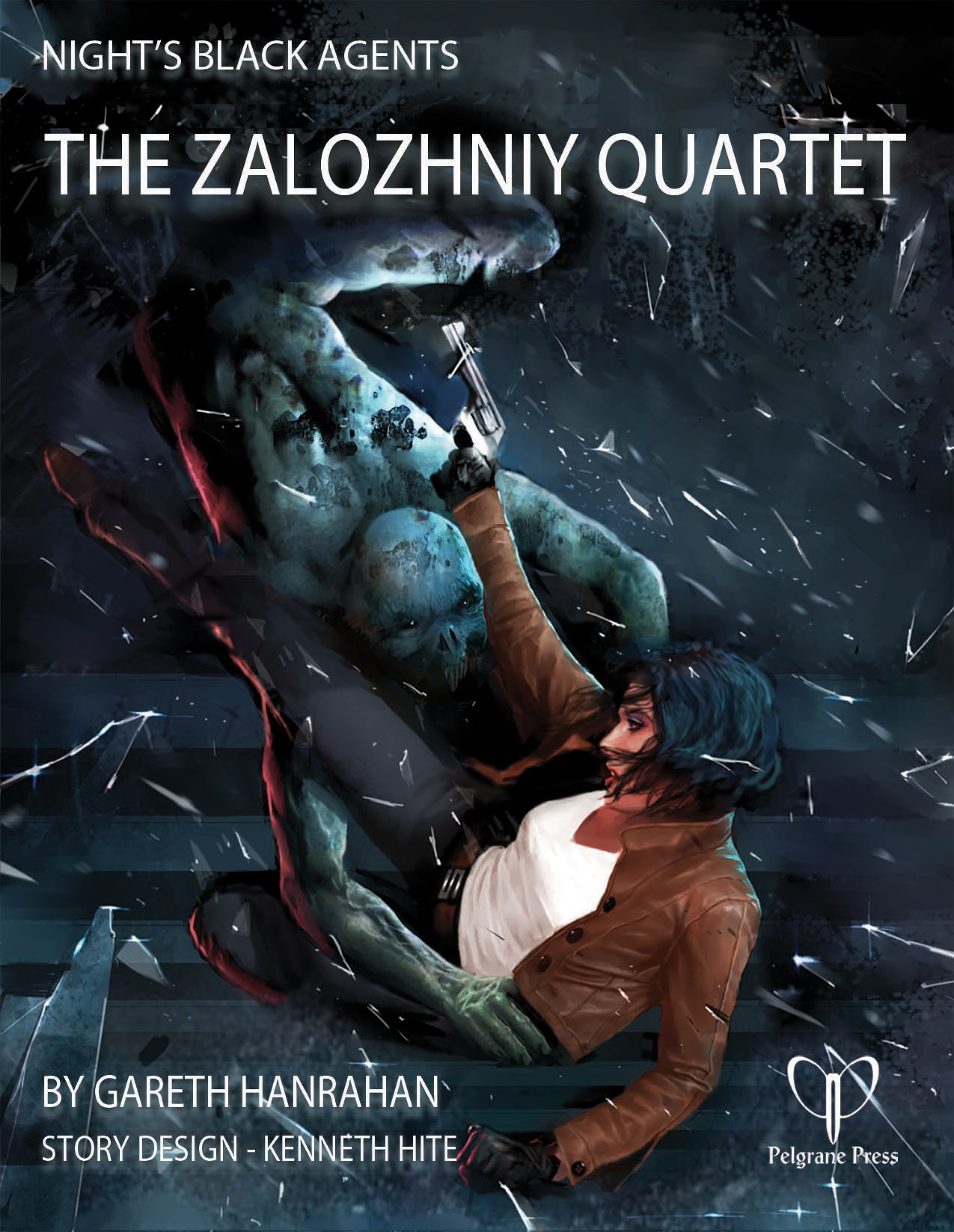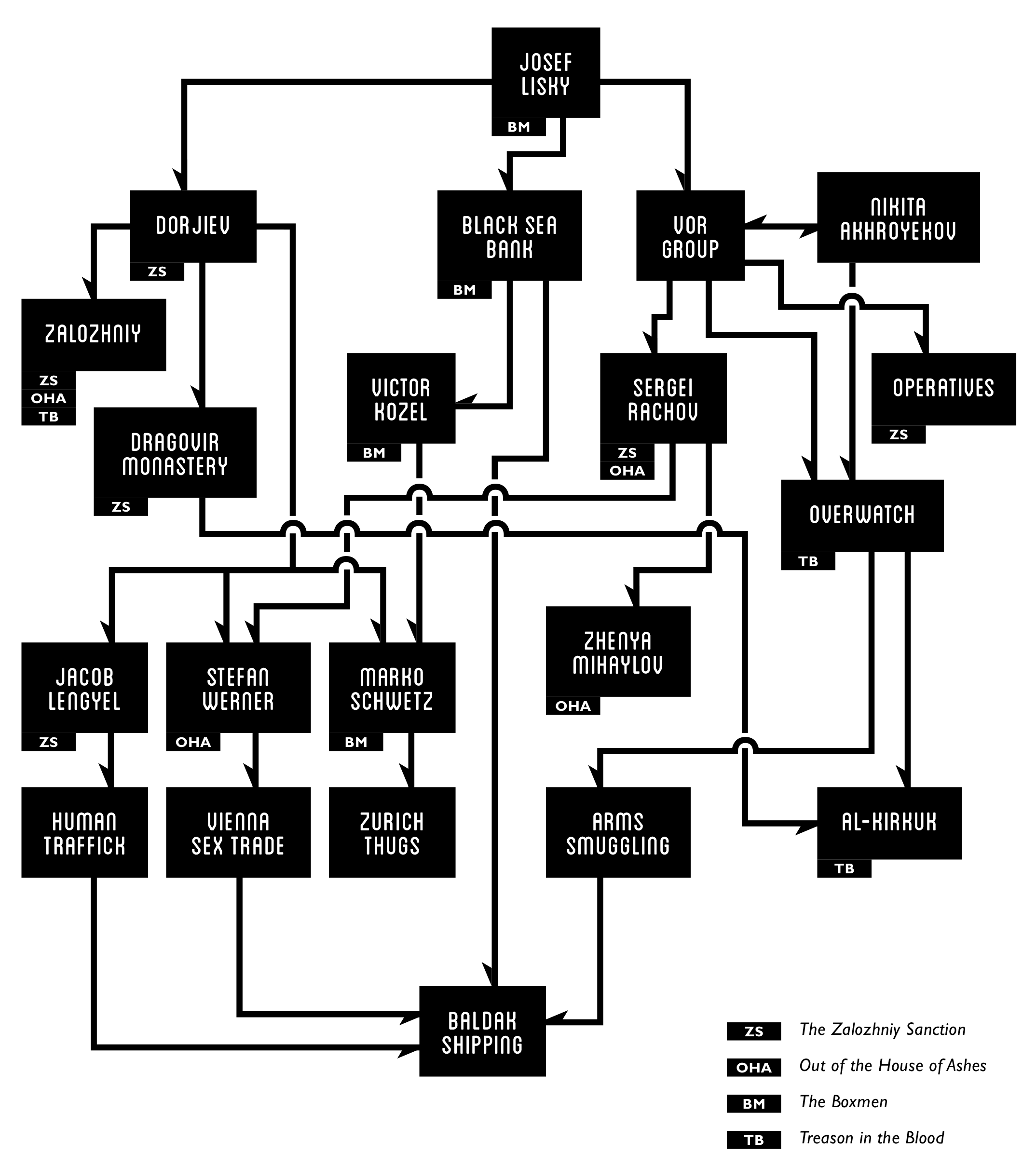The Zalozhniy Quartet is a mini-campaign for Night’s Black Agents, the thriller RPG where retired special ops agents discover that vampires are real and then vow to destroy the undead conspiracy once and for all.
Or, at least, that’s what I’m choosing to call it.
The Quartet bills itself as a “thriller story arc of four missions,” in which “each of the missions can be played individually, or linked into a campaign in any order.” But this doesn’t seem to hold up to close inspection.
We’ll come back to that.
SPOILER WARNING!
This review is absolutely going to ruin the twists and surprises of The Zalozhniy Quartet for you. So if you have any intention of playing in this mini-campaign at some point in the future, you should leap through the nearest window and make a daring escape. (Figuratively speaking.)
The major opposition of the Quartet is the Lisky Bratva, a Russian mafia that has figured out how to create the zalozhniy: Vampiric entities whose moment of death has been undone, transforming them into killing machines that can only be stopped if you recreate the lethal wound which has been “edited” out of their personal timeline. For an extra creep factor, this temporal meddling causes all kinds of weird, non-linear events whenever a zalozhniy is near.
In addition to the criminal machinations of the Lisky Bratva, the Quartet also features the Philby Plot, in which the historical figures of Henry St. John Philby and his son Kim Philby, both spies whom infamously betrayed the British government during the 20th century, are revealed to have been part of an alchemical plot in which the entire Saudi royal bloodline was given a vampiric contamination. Anyone who can track down the tri-partite alchemical reagents known as the Albedo, Nigredo, and Rubedo will be able to complete St. John’s final ritual, transform the entire Saudi royal family into their vampiric thralls, and take de facto control of one of the richest nations on the planet.
… guess what the Lisky Bratva want?
Together, the zalozhniy and the Philby Plot form two fantastic pillars for The Zalozhniy Quartet to build around. The myriad individual ops are also great – varied, dynamic, and well-tuned to show off the strengths of the Night’s Black Agents system.
The basic bottom line here is that the core of the Quartet is very good. Personally, I find the concepts compelling and the raw material useful. It’s the type of adventure that you read and think, “I can’t wait to see what my players do with this!” And, as a testament to that, I’m currently halfway through running a Zalozhniy Quartet campaign.
So, obviously, I’m going to recommend The Zalozhniy Quartet. If you have any interest in Night’s Black Agents, this gives you a lot of awesome stuff to play with and great bang-for-your-buck.
But I do have some reservations.
THE FLY IN RENFIELD’S OINTMENT
Robin D. Laws often says that published adventures are valuable because they teach you what and how to prep for the game.
And that’s the problem with The Zalozhniy Quartet: This is not how you’re supposed to prep a Night’s Black Agents campaign.
A Night’s Black Agents campaign is organized around the Conspyramid, a selection of nodes — sources of blood, funding, and protection; cults, institutions, infrastructure, front companies, etc. — arranged into a pyramidal form and connected to each other, creating a model of the vampiric conspiracy which the agents will navigate.
This is not, however, what The Zalozhniy Quartet does.
Now, to be fair, the intention of the Quartet is that it can be plugged into your existing Conspyramid. For example, if you have a Russian mafia node on your Conspyramid, you can just use the Lisky Bratva! This is why the book says the adventures can be played in any order, because the idea seems to be that each adventure can be plugged in as a separate node on your Conspyramid (and the agents should be free to navigate the Conspyramid without being locked into a sequence).
This is good in theory, but the actual execution is flawed.
For example, the adventures can’t actually be played in any order. At least, not as written. There are too many continuity errors, including one instance where, if the PCs aren’t playing them in the right sequence, there’s supposed to be a phone call that basically says, “The stuff that happens in the other adventure is already over-and-done. You missed it.” Another of the missions — “The Zalozhniy Sanction” — is clearly designed to be played first.
I suspect this is because the series was originally designed to be played in sequence, and then at some point in development it was decided that they should become modular. The retrofit, however, was slapdash, and it wreaked havoc on the book.
For example, if the adventures can be played in any sequence, then logically each adventure should include clues pointing to all the other adventures. And this is true. Except the clues aren’t integrated into the adventures. Instead, they’re listed as separate Exit Vectors and Entry Vectors for each scenario, which also don’t match each other. (So, for example, the entry vectors for “Out of the Ashes” say that PCs in “The Boxmen” will be able to trace the owner of a safe deposit box or some business correspondence to get to “Out of the Ashes.” But if you check the Exit Vectors for “The Boxmen” these clues do not appear!)
It’s difficult to really express how intensely unfriendly this presentation is to the GM.
Similarly, the book also provides an adversary roster for the Lisky Bratva:
At first glance, this seems useful. Except:
- There are significant continuity errors between the structure shown on the map and the structure described in the text of the book; and
- The structure shown in the diagram doesn’t match the structure of play.
See, the function of an adversary roster in Night’s Black Agents is to guide the players’ investigation: They follow the connections from one adventure to the next.
But there’s no way to do that in The Zalozhniy Quartet as written, because, in addition to the damage wrought by the retrofit, the original structure of the scenario was clearly a linear railroad and that structure hasn’t actually been removed!
You can see this very clearly, for example, in the first adventure in the book, “The Zalozhniy Sanction.” The PCs are hired to investigate a Lisky Bratva smuggling operation, but the job is scripted to fail and the GM needs to force them to go on the run. (Oof.)
And not just on the run in general (despite the extended chase rules in Night’s Black Agents being specifically designed to empower the players to choose how and where they run to). The GM needs to force the PCs to specifically make a run to their handler’s safe house in Vienna. (Oof again.)
With the PCs forced onto this path, an effort is then made to actually invoke the extended chase rules… except that just won’t do, because on their way to Vienna, the PCs need to be dragged through a whole sequence of ops:
- Sabotaging a football team
- Infiltrating a vampire monastery
- Rescuing an investigative reporter
- Breaking up a human trafficking ring
- Disrupting a mafia meeting
So the extended chase rules are invoked in name-only, but don’t actually do anything. (Oof a third time.)
(This “just ignore the chase rules” thing happens quite a bit in the adventure. For example, there’s a thriller chase elsewhere in the adventure where if the PCs lose the chase, the target they’re chasing goes boom; but if they win the chase, then the target goes boom and so does a PC. Which is backassed adventure design.)
Plus, this whole thing doesn’t really make any sense because the Lisky Bratva’s reaction to the PCs is insanely out of proportion. For example, they stage a major terrorist incident killing hundreds of people in an effort to silence some people who… tried but failed to steal some intel?
Then, on top of all this, the Quartet’s best intentions end up biting it in the ass: It wants to be something that any Night’s Black Agents GM can plug into their campaign, which is admirable. But Night’s Black Agents notably includes a system for creating custom vampires, which means in any given campaign they could be anything from Nosferatu to psychic statues to alien space vapor.
So as you draw towards the finale of The Zalozhniy Quartet and, in particular, the Philby Plot comes into focus, the writers have a problem:
- What, exactly, did Philby do?
- What, exactly, are the albedo, rubedo, and nigredo?
- What, exactly, does the final ritual entail?
And so forth.
In a quest for genericness, the writers literally can’t answer these questions. They do, to their credit, offer you a bunch of options, but they are, perforce, vague options. They can’t actually nail anything down, which means they also can’t design concrete, playable scenarios. The inevitable result is that, as the campaign reaches its grand conclusion, it just kind of dissolves into a mushy non-entity.
CONCLUSION
That seems like a lot of problems. And it is.
But I also said that The Zalozhniy Quartet is very good and that I heartily recommend it.
So… what gives?
Well, remember those ops I mentioned above? They’re all pretty great. So are the other ops in the book:
- Extracting an enemy intelligence agent
- Performing a heist on a private Swiss bank
- Raiding a museum in Baghdad
- Tracking down the Thing Which Was Once St. John
So, yes. There are some large scale structural problems. But the actual adventure content ranges from pretty good to really good, and the core pillars of the campaign — the zalozhniy and the Philby Plot — are conceptually fantastic (even if you need to fill in a few holes).
Plus, here’s the great thing: Night’s Black Agents already has an incredibly flexible and robust campaign structure. Remember the Conspyramid? All you need to do is pull the ops out of the book, plug them into a fully functional Conspyramid, and you’re good to go. As remixes go, Night’s Black Agents makes this one really simple.
Don’t get me wrong. If The Zalozhniy Quartet wasn’t so messy, it would receive a significantly higher grade from me. It doesn’t take much imagination, in fact, to see that it might have been one of the best RPG campaigns ever written. Unfortunately, that’s not the case, and what we’re left with is a flawed masterpiece.
But even a flawed masterpiece is going to create some pretty cool experiences at your table.
Good hunting!
Grade: B-
Author: Gareth Hanrahan
Story Design: Kenneth Hite
Publisher: Pelgrane Press
Cost: $26.95
Page Count: 148
FURTHER READING
Review: Night’s Black Agents













